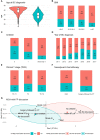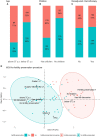Factors Associated With the Discussion of Fertility Preservation in a Cohort of 1,357 Young Breast Cancer Patients Receiving Chemotherapy
- PMID: 34650912
- PMCID: PMC8507557
- DOI: 10.3389/fonc.2021.701620
Factors Associated With the Discussion of Fertility Preservation in a Cohort of 1,357 Young Breast Cancer Patients Receiving Chemotherapy
Abstract
Purpose: Female breast cancer (BC) patients exposed to gonadotoxic chemotherapy are at risk of future infertility. There is evidence of disparities in the discussion of fertility preservation for these patients. The aim of the study was to identify factors influencing the discussion of fertility preservation (FP).
Material and methods: We analyzed consecutive BC patients treated by chemotherapy at Institut Curie from 2011-2017 and aged 18-43 years at BC diagnosis. The discussion of FP was classified in a binary manner (discussion/no discussion), based on mentions present in the patient's electronic health record (EHR) before the initiation of chemotherapy. The associations between FP discussion and the characteristics of patients/tumors and healthcare practitioners were investigated by logistic regression analysis.
Results: The median age of the 1357 patients included in the cohort was 38.7 years, and median tumor size was 30.3 mm. The distribution of BC subtypes was as follows: 702 luminal BCs (58%), 241 triple-negative breast cancers (TNBCs) (20%), 193 HER2+/HR+ (16%) and 81 HER2+/HR- (6%). All patients received chemotherapy in a neoadjuvant (n=611, 45%) or adjuvant (n= 744, 55%) setting. A discussion of FP was mentioned for 447 patients (33%). Earlier age at diagnosis (discussion: 34.4 years versus no discussion: 40.5 years), nulliparity (discussion: 62% versus no discussion: 38%), and year of BC diagnosis were the patient characteristics significantly associated with the mention of FP discussion. Surgeons and female physicians were the most likely to mention FP during the consultation before the initiation of chemotherapy (discussion: 22% and 21%, respectively). The likelihood of FP discussion increased significantly over time, from 15% in 2011 to 45% in 2017. After multivariate analysis, FP discussion was significantly associated with younger age, number of children before BC diagnosis, physicians' gender and physicians' specialty.
Conclusion: FP discussion rates are low and are influenced by patient and physician characteristics. There is therefore room for improvement in the promotion and systematization of FP discussion.
Keywords: breast cancer; chemotherapy; discussion; fertility preservation; oncofertility.
Copyright © 2021 Hours, Toussaint, De Castelbajac, Sautter, Borghese, Frank, Coussy, Laas, Grandal, Dumas, Daoud, Guerin, Balezeau, Feron, Fourchotte, Kirova, Lerebours, Pierga, Guillot, Santulli, Grynberg, Sonigo, Reyrat, Soibinet-Oudot, Reyal and Hamy.
Conflict of interest statement
The authors declare that the research was conducted in the absence of any commercial or financial relationships that could be construed as a potential conflict of interest.
Figures



Similar articles
-
The positive effect of a dedicated adolescent and young adult fertility program on the rates of documentation of therapy-associated infertility risk and fertility preservation options.Support Care Cancer. 2017 Jun;25(6):1915-1922. doi: 10.1007/s00520-017-3597-8. Epub 2017 Feb 2. Support Care Cancer. 2017. PMID: 28155019
-
Random start ovarian stimulation for fertility preservation appears unlikely to delay initiation of neoadjuvant chemotherapy for breast cancer.Hum Reprod. 2017 Oct 1;32(10):2123-2129. doi: 10.1093/humrep/dex276. Hum Reprod. 2017. PMID: 28938748
-
Fertility preservation does not delay the initiation of chemotherapy in breast cancer patients treated with adjuvant or neo-adjuvant chemotherapy.Breast Cancer Res Treat. 2020 Nov;184(2):433-444. doi: 10.1007/s10549-020-05858-1. Epub 2020 Aug 13. Breast Cancer Res Treat. 2020. PMID: 32794060
-
Breast cancer under age 40: a different approach.Curr Treat Options Oncol. 2015 Apr;16(4):16. doi: 10.1007/s11864-015-0334-8. Curr Treat Options Oncol. 2015. PMID: 25796377 Review.
-
A Study Protocol for the Australasian Oncofertility Registry: Monitoring Referral Patterns and the Uptake, Quality, and Complications of Fertility Preservation Strategies in Australia and New Zealand.J Adolesc Young Adult Oncol. 2016 Sep;5(3):215-25. doi: 10.1089/jayao.2015.0062. Epub 2016 Mar 16. J Adolesc Young Adult Oncol. 2016. PMID: 26981848 Review.
Cited by
-
French national survey on breast cancer care: caregiver and patient views.Breast Cancer. 2024 Jul;31(4):633-642. doi: 10.1007/s12282-024-01576-4. Epub 2024 Apr 18. Breast Cancer. 2024. PMID: 38635135 Free PMC article.
References
-
- Le Cancer Du Sein - Les Cancers Les Plus Fréquents . Available at: https://www.e-cancer.fr/Professionnels-de-sante/Les-chiffres-du-cancer-e....
LinkOut - more resources
Full Text Sources
Research Materials
Miscellaneous

